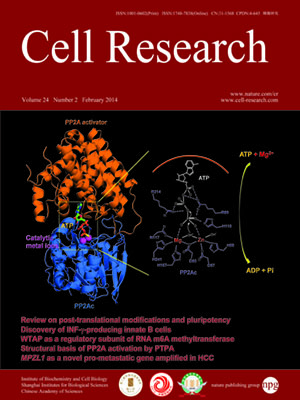
Volume 24, No 2, Feb 2014
ISSN: 1001-0602
EISSN: 1748-7838 2018
impact factor 17.848*
(Clarivate Analytics, 2019)
Volume 24 Issue 2, February 2014: 233-246 | Open Access
ORIGINAL ARTICLES
Lsm2 and Lsm3 bridge the interaction of the Lsm1-7 complex with Pat1 for decapping activation
Donghui Wu1, Denise Muhlrad2, Matthew W Bowler3,4, Zhou Liu5, Roy Parker2 and Haiwei Song1,5,6
1Institute of Molecular and Cell Biology, 61 Biopolis Drive, Singapore 138673
2Department of Biochemistry and Howard Hughes Medical Institute, University of Colorado, Boulder, Boulder CO 80303, USA
3European Molecular Biology Laboratory, 6 rue Jules Horowitz, BP 181, 38042, Grenoble, France
4Unit of Virus Host-Cell Interactions, UJF-EMBL-CNRS, UMI 3265, 6 rue Jules Horowitz, 38042 Grenoble Cedex 9, France
5Life Sciences Institute, Zhejiang University, 388 Yuhangtang Road, Hangzhou, Zhejiang 310000, China
6Department of Biochemistry, National University of Singapore, 14 Science Drive, Singapore 117543
Correspondence: Haiwei Song, Tel: +65 65869700(haiwei@imcb.a-star.edu.sg)
The evolutionarily conserved Lsm1-7-Pat1 complex is the most critical activator of mRNA decapping in eukaryotic cells and plays many roles in normal decay, AU-rich element-mediated decay, and miRNA silencing, yet how Pat1 interacts with the Lsm1-7 complex is unknown. Here, we show that Lsm2 and Lsm3 bridge the interaction between the C-terminus of Pat1 (Pat1C) and the Lsm1-7 complex. The Lsm2-3-Pat1C complex and the Lsm1-7-Pat1C complex stimulate decapping in vitro to a similar extent and exhibit similar RNA-binding preference. The crystal structure of the Lsm2-3-Pat1C complex shows that Pat1C binds to Lsm2-3 to form an asymmetric complex with three Pat1C molecules surrounding a heptameric ring formed by Lsm2-3. Structure-based mutagenesis revealed the importance of Lsm2-3-Pat1C interactions in decapping activation in vivo. Based on the structure of Lsm2-3-Pat1C, a model of Lsm1-7-Pat1 complex is constructed and how RNA binds to this complex is discussed.
10.1038/cr.2013.152
FULL TEXT | PDF
Browse 1960


